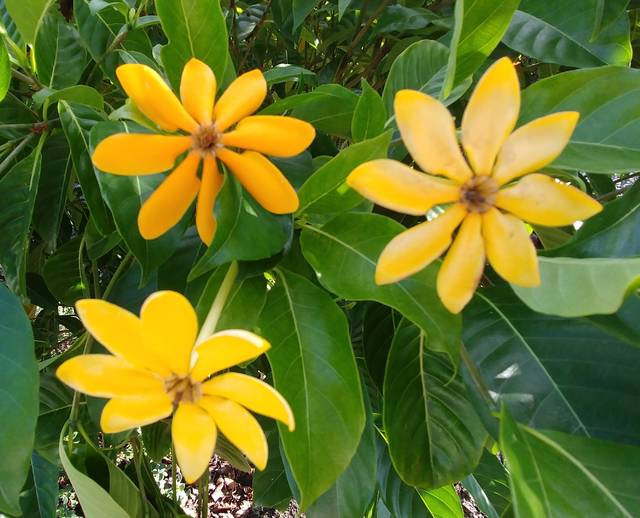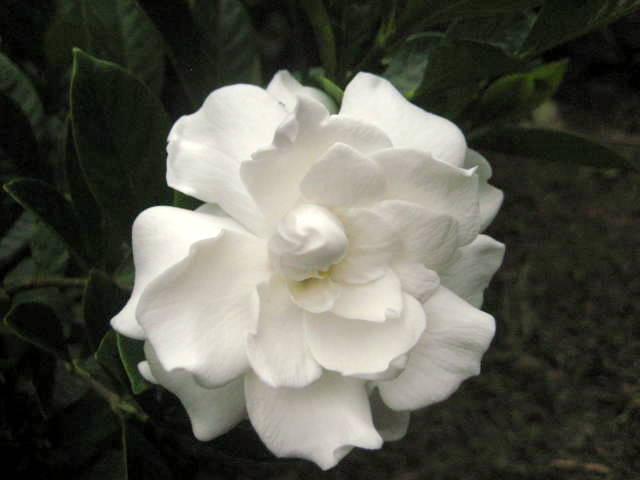Plant of the month: Gardenia


This spring you might want to add some fragrance to your landscape. Though we often think of planting the tropical plumeria outside our windows to waft its sweet aroma into our homes, several sub-tropical gardenias can serve a similar purpose.
This spring you might want to add some fragrance to your landscape. Though we often think of planting the tropical plumeria outside our windows to waft its sweet aroma into our homes, several sub-tropical gardenias can serve a similar purpose.
Most of us are familiar with the standard gardenia (gardenia augusta) with its beautiful white blossoms and their lovely sweet scent. Native to sub-tropical Asia, the standard and its cultivars usually grow best in somewhat moist, acidic soils enriched with organic matter. They also seem to prefer the slightly cooler temperatures at upper elevations. This gardenia requires special attention to thrive here, especially at lower elevations.
The gardenia genus is in the rubiaceae (coffee) family and has more than 200 species. Several of these are better suited to the conditions found in Kona.
One good example of a gardenia that grows well in the somewhat drier and hotter conditions at lower elevations is the gardenia taitensis, the tiare or Tahitian gardenia. A native of Polynesia, this lovely evergreen plant can be maintained as part of a hedge or can serve as a specimen shrub or small tree. Planted in full sun in good garden soil, the plants can grow quickly to 20 feet high but will tolerate pruning to achieve the desired height and shape.
The tiare has the classic shiny dark green leaves of the standard but they are often much larger. In ideal conditions, tiare leaves can be nearly 8-inches long and 4-inches wide. The flowers have a heady fragrance like their cousin, but are different in shape. The pinwheel shaped blossoms can be 4 inches across with eight petals (or blades) around a short trumpet-like base.
The plants are fairly salt tolerant and can be grown in gardens right on the ocean but should be protected from strong winds. They are also constant bloomers and will usually bear flowers year round. Their do produce fruit occasionally but the seeds inside tend to be sterile. The best way to propagate Tahitian gardenias is through cuttings.
Another good gardenia for Hawaiian gardens is the kula. Gardenia tubifera kula, or the golden gardenia, is a spectacular specimen plant from Southeast Asia. The beautiful single blossoms are 2 to 3 inches across with eight petals. Kula flowers change color as they mature which is a feature unique to the gardenia genus. They open cream colored then change to yellow and finally to gold before dropping at the end of their lifecycle. The flowers have a strong, sweet fragrance somewhat similar to the standard gardenia.
Kula can be grown as a large, shrub but can also be trained into a small tree. The plant grows slowly and can reach 25 feet or more in ideal conditions. This gardenia, like the standard, prefers moist, fertile, acidic soil containing organic matter. It can be grown in partial shade below 1,000 feet or full sun at upper elevations. It will produce its lovely fragrant flowers nearly year round. Similar to the standard gardenia, this cultivar is not salt or wind tolerant and will not do well in long periods of drought. Though the plant is not easy to propagate, well-tended cuttings can be successful.
The native nanu gardenias (gardenia brighamii and remyi) are lovely small trees for mid to upper elevation gardens. These plants are native to Hawaii’s dryland forests but can be grown successfully elsewhere. Their fragrant white flowers have six soft petals that converge in a short tube. Both have the classic glossy dark green leaves of the gardenia genus, though the brighamii has smaller leaves and is a less vigorous plant.
Both of the native gardenias produce seed pods occasionally, but using cuttings is the best propagation method. Hardwood or semi-hardwood cuttings work best though they can take six months or more to root.
The plant with the common name cinnamon gardenia is not actually in the gardenia genus. This African native, tabernaemontana africana, is in the apocynaceae family, but the plant and its flowers resemble gardenias in many ways.
Cinnamon gardenia’s white, pinwheel flowers have five long curly petals and a strong fragrance that is very reminiscent of gardenias. The shrub has large glossy green leaves and it will usually grow well even in poor soil at lower elevations. With a year round blooming cycle here in Hawaii, this heavy scented shrub is an ideal addition to any garden. Though it does occasionally produce fruit with seeds, it is also best propagated from cuttings.
If you decide to grow the standard gardenia, your shrub will likely bloom more often and more profusely if you meet its precise requirements. This gardenia is a heavy feeder preferring a rich, moist, slightly acid soil with light doses of a balanced fertilizer applied monthly.
Gardenia augusta will produce more flowers when the daytime temperatures are warm but not hot and the nighttime temperatures are cool. These conditions are best met at elevations above 1,000 feet. If your shrub is at a lower elevation, it will do best in partial shade. Standard gardenias prefer humid conditions. If you do not have regular rainfall you may want to mist your gardenia or just give the entire shrub a hose bath several times a week.
Since gardenias produce flower buds on both new and old growth, you should prune cautiously and only when necessary. The best time to prune is immediately after a full flowering has occurred. Over-pruning can remove potential flower buds.
Buds may drop or fail to form if the conditions are too dry, too hot or the plants lack adequate sun exposure. Overwatering can also cause bud drop. The soil should be relatively moist, but drain well so it doesn’t get soggy.
All gardenias are subject to insect attacks from scale, aphids and thrips. Most insect pests of gardenias can be killed on contact using a soap and oil combination though a pyrethroid insecticide may be needed to get rid of thrips. Early detection and treatment is the key to insect control in these lovely plants.
You can often find these plants at local nurseries or even in the garden centers at big box stores. If you can’t find them, give Margo Lundstrom a call at 329-7593. Though she has closed her Sunrise Nursery, she is still serving clients with special requests.
Adding beauty and fragrance to your garden can be well served by the addition of any of these gardenias.
Diana Duff is a plant adviser, educator and consultant living on an organic farm in Captain Cook.
Gardening Events
Tuesday: “Making Chocolate” from 5:30-6:30 p.m. at the Kailua-Kona Public Library. As part of the Community Seed Library lecture series Master Gardener Celeste Makervis will demonstrate the process of making small batch chocolate at home. Free event. Info: 327-4327.
Friday: “32nd Annual Mother’s Day Weekend Orchid Show, Plant &Craft Sale” from 9 a.m. to 6 p.m. at the Old Kona Airport Pavilion with vendors selling orchids, herbs, cactus, succulents, fruit trees and other garden plants as well as crafts. Classes from 11 a.m. to 2 p.m. Open to the public. Info: https://www.konaorchidsociety.org/our-annual-show-and-sale
Saturday: “32nd Annual Mother’s Day Weekend Orchid Show, Plant &Craft Sale” continues from 8 a.m. to 4 p.m. at the Old Kona Airport Pavilion.
“Work Day at Amy Greenwell Garden” from 9 a.m. to 12:30 p.m. Meet at the Garden Visitor Center across from the Manago Hotel in Captain Cook. Volunteers will be able to help with garden maintenance and are invited to bring a brown bag lunch. Water and snacks provided. Info: Peter at 323-3318.
Farmer Direct Markets
Wednesday: “Sunset Farmers Market” 2-6 p.m. in the HPM parking lot, 74-5511 Luhia Street in Kailua-Kona (across from Target)
Wednesday: “Hooulu Farmers Market” 9 a.m. to 2 p.m. at Sheraton Kona Resort &Spa at Keauhou Bay
Friday: “Pure Kona Market” 9 a.m. to 5 p.m. at Amy Greenwell Garden in Captain Cook
Saturday: “Keauhou Farmers Market” 8 a.m. to noon at Keauhou Shopping Center
“Kamuela Farmer’s Market” from 7 a.m. to noon at Pukalani Stables
Sunday: “Pure Kona Green Market” 9 a.m. to 2 p.m. at Amy Greenwell Garden in Captain Cook
“Hamakua Harvest” 9 a.m. to 2 p.m. at Highway 19 and Mamane Street in Honokaa.
Plant Advice Lines
Anytime: konamg@ctahr.hawaii.edu
Tuesdays &Thursdays: 9 a.m. to noon at UH-CES in Kainaliu – 322-4892
Mon., Tues. &Fri: 9 a.m. to noon at UH CES at Komohana in Hilo 981-5199 or himga@hawaii.edu


